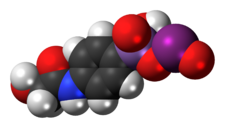Glycobiarsol
 | |
 | |
| Names | |
|---|---|
| Preferred IUPAC name Oxobismuthanyl hydrogen [4-(2-hydroxyacetamido)phenyl]arsonate | |
| Other names [4-[(2-Hydroxyacetyl)amino]phenyl]-oxobismuthanyl-oxyarsinic acid | |
| Identifiers | |
CAS Number |
|
3D model (JSmol) |
|
| ChemSpider |
|
| ECHA InfoCard | 100.003.767 |
| EC Number |
|
| KEGG |
|
PubChem CID |
|
| UNII |
|
CompTox Dashboard (EPA) |
|
InChI
| |
| |
| Properties | |
Chemical formula | C8H9AsBiNO6 |
| Molar mass | 499.063 g·mol−1 |
| Pharmacology | |
| P01AR03 (WHO) QP51AD03 (WHO) QP51AD53 (WHO) | |
Except where otherwise noted, data are given for materials in their standard state (at 25 °C [77 °F], 100 kPa). Infobox references | |
Chemical compound
Glycobiarsol (trade name Milibis) is an organometallic antiprotozoal agent that has been used in humans[1] as well as in dogs.[2]
References
- ^ Berberian, D. A. (1954). "The trichomonacidal activity of milibis (glycobiarsol)". New York State Journal of Medicine. 54 (22): 3102–3105. PMID 13214428.
- ^ Kibble, R. M. (1969). "Glycobiarsol for the control of Trichuris vulpis infection in the dog". Australian Veterinary Journal. 45 (8): 387. doi:10.1111/j.1751-0813.1969.tb06633.x. PMID 5389346.
- v
- t
- e
| Tissue amebicides |
| ||||||
|---|---|---|---|---|---|---|---|
| Luminal amebicides |
| ||||||
| Other/ungrouped |
|
- #WHO-EM
- ‡Withdrawn from market
- Clinical trials:
- †Phase III
- §Never to phase III
 | This antiinfective drug article is a stub. You can help Wikipedia by expanding it. |
- v
- t
- e










